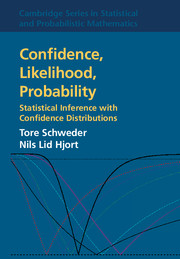Book contents
- Frontmatter
- Dedication
- Contents
- Preface
- 1 Confidence, likelihood, probability: An invitation
- 2 Inference in parametric models
- 3 Confidence distributions
- 4 Further developments for confidence distribution
- 5 Invariance, sufficiency and optimality for confidence distributions
- 6 The fiducial argument
- 7 Improved approximations for confidence distributions
- 8 Exponential families and generalised linear models
- 9 Confidence distributions in higher dimensions
- 10 Likelihoods and confidence likelihoods
- 11 Confidence in non- and semiparametric models
- 12 Predictions and confidence
- 13 Meta-analysis and combination of information
- 14 Applications
- 15 Finale: Summary, and a look into the future
- Overview of examples and data
- Appendix: Large-sample theory with applications
- References
- Name index
- Subject index
5 - Invariance, sufficiency and optimality for confidence distributions
Published online by Cambridge University Press: 05 March 2016
- Frontmatter
- Dedication
- Contents
- Preface
- 1 Confidence, likelihood, probability: An invitation
- 2 Inference in parametric models
- 3 Confidence distributions
- 4 Further developments for confidence distribution
- 5 Invariance, sufficiency and optimality for confidence distributions
- 6 The fiducial argument
- 7 Improved approximations for confidence distributions
- 8 Exponential families and generalised linear models
- 9 Confidence distributions in higher dimensions
- 10 Likelihoods and confidence likelihoods
- 11 Confidence in non- and semiparametric models
- 12 Predictions and confidence
- 13 Meta-analysis and combination of information
- 14 Applications
- 15 Finale: Summary, and a look into the future
- Overview of examples and data
- Appendix: Large-sample theory with applications
- References
- Name index
- Subject index
Summary
The previous two chapters have dealt with the basic concepts, motivation and machinery for confidence distributions and confidence curves. Here we first discuss ways of reducing problems to simpler ones via the paths of invariance and sufficiency, involving also the concepts of loss functions, risk functions and power functions for confidence distributions. A Rao–Blackwell type result is reached about lowering the expected confidence loss via sufficiency. We furthermore provide a Neyman–Pearson type optimality result valid for certain confidence procedures, applicable in particular to the exponential class of distributions and to the natural parameters of generalised linear models.
Confidence power
Let C(ψ) be the confidence distribution function for some one-dimensional focus parameter ψ. The intended interpretation of C is that its quantiles are endpoints of confidence intervals. For these intervals to have correct coverage probabilities, the cumulative confidence at the true value of the parameter must have a uniform probability distribution. This is an ex ante statement. Before the data have been gathered, the confidence distribution is a statistic with a probability distribution, often based on another statistic through a pivot.
The choice of statistic on which to base the confidence distribution is unambiguous only in simple cases. Barndorff-Nielsen and Cox (1994) are in agreement with Fisher when emphasising the structure of the model and the data as a basis for choosing the statistic. They are primarily interested in the logic of statistical inference. In the tradition of Neyman and Wald, emphasis has been on inductive behaviour, and the goal has been to find methods with optimal frequentist properties. In exponential families and in other models with Neyman structure (see Lehmann 1959, chapter 4), it turns out that methods favoured on structural and logical grounds usually also are favoured on grounds of optimality. This agreement between the Fisherian and Neyman–Wald schools is encouraging and helps to reduce the division between these two lines of thought.
Example 5.1 Upper endpoint of a uniform distribution
Assume Y1,…,Yn are independent from the uniform distribution on [0, θ], and consider both Vn = Y(n) and Un = Y(n−1), the largest and second largest among the observations. Then both Vn/θ and Un/θ are pivots, hence each giving rise to confidence distributions.
Information
- Type
- Chapter
- Information
- Confidence, Likelihood, ProbabilityStatistical Inference with Confidence Distributions, pp. 154 - 184Publisher: Cambridge University PressPrint publication year: 2016
